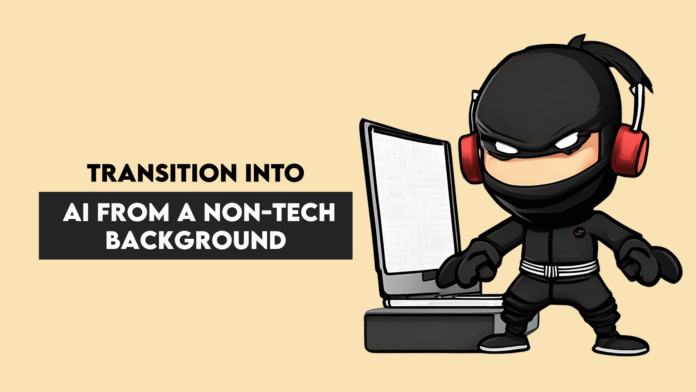Image by Author | Canva
Do you think only mathematicians and software engineers can work in AI? Well, you’re wrong if you do. Many people who are successful in data science and AI don’t have a tech background.
So, yes, you can transition into AI even if you have started your career in, for example, marketing, psychology, law, design, and so on.
Here are five practical ways to do so.
1. Become the AI Person on Your Team
You don’t need permission to start using AI in your team. Well, in most cases, you don’t. One issue might be sharing company data with AI tools. Nevertheless, be the one who will explore those tools, get familiar with them, and possibly bring more efficiency to your team.
You know how in every team there’s an Excel champion or an SQL god? You can be that person for AI. The idea is to start small, for example:
2. Learn the Technical Basics
You don’t need to start coding a machine learning model immediately. Start with the basics of what machine learning and AI are. Get familiar with the basic terminology and tools.
Here’s an overview of the technology you should know.

Here are also tools you can start to familiarize yourself with.

Resources for further info:
3. Position Yourself as an AI Translator
AI doesn’t exist in a vacuum; it’s there to solve actual problems. If we’re talking about business problems, then domain expertise is needed for machine learning and AI to provide adequate solutions. Guess who provides that expertise? That’s right. You!
Use that knowledge to position yourself as an AI translator, a bridge between tech and non-tech stakeholders. You can:
- Translate business problems into data problems
- Know how AI fits into them
- Spot flaws in the machine learning model assumptions
- Explain model outputs to non-technical stakeholders
That way, you start by understanding certain aspects of machine learning modeling, e.g., translating model results, such as the confusion matrix and accuracy, into real-world impact. From this high-level understanding of AI, you can slowly transition into building actual models, if that’s your goal.
4. Start With No-Code or Low-Code Tools
You don’t have to work for years on your Python proficiency before you start building some less complex machine learning models. Today, there are already many tools that allow you to build an AI project with no or low code by utilizing their drag-and-drop interfaces.
They will also help you position yourself as a translator. These tools + your domain knowledge can demonstrate that you:
- Understand a real-world problem
- Can identify an AI solution
- Use that AI solution to solve the problem
Here are some tools you’ll find useful.
| Category | Tool | What You Can Do |
|---|---|---|
| No-Code AI Builders | Lobe.ai | Train image classifiers with a drag-and-drop UI. |
| Teachable Machine | Build simple classification models in the browser. | |
| MonkeyLearn | Create custom NLP models for sentiment, topic, or intent. | |
| Obviously AI/Zams | Upload a CSV and run binary classification or regression. | |
| Low-Code AI Builders | KNIME | Build ML workflows using visual nodes (low-code, good for tabular data). |
| DataRobot | Upload data, select models, and deploy with minimal coding. | |
| Microsoft Azure ML Designer | Build and deploy machine learning models using drag-and-drop modules for data prep, training, and evaluation. | |
| AI-Powered Creative & Productivity Tools | Runway ML | Remove video backgrounds, generate images from text. |
| Durable | Build a landing page for a business in seconds. | |
| Jasper AI | Write ad copy, product descriptions, blog intros. | |
| Canva AI | Auto-generate captions, remove image backgrounds. | |
| Notion AI | Summarise notes, draft content, extract key points. | |
| Descript | Edit podcasts or videos like a text doc. | |
| ChatGPT | Brainstorm ideas, summarise reports, draft content. |
5. Pivot into AI-Adjacent Roles
A great start for pivoting to AI is moving into roles that require some AI knowledge, but don’t require building an actual model. Such positions are:
- Project managers – for coordination between stakeholders and machine learning engineers/data scientists
- Technical writers – for documenting workflows and writing user guides
- Product designers – for understanding how users interact with AI systems
- Policy analysts – for flagging risks such as fairness and explainability in AI systems
All these positions will also give you the opportunity to learn as you go. It can provide a solid foundation for transitioning into actual model building, as AI is becoming more and more a part of many job roles.
Conclusion
Data scientists and machine learning engineers are not the only positions that work in AI. Many people from a non-technical background do, too.
While transitioning, don’t write off what you already know as useless. Find an intersection between machine learning and domain knowledge, and start from that point. Then, as you learn more about AI, you can decide if you want to go into building actual machine learning models or remain a bridge between technical and non-technical stakeholders.
Nate Rosidi is a data scientist and in product strategy. He’s also an adjunct professor teaching analytics, and is the founder of StrataScratch, a platform helping data scientists prepare for their interviews with real interview questions from top companies. Nate writes on the latest trends in the career market, gives interview advice, shares data science projects, and covers everything SQL.
